Abstract
1 The nature of the 5-hydroxytryptamine (5-HT) receptors which amplify the vasoconstrictor effect of methoxamine was examined in the rabbit isolated perfused ear artery with intact endothelium. Indices of amplification were leftward shifts of methoxamine dose-response (DR) curves produced by 5-HT (0.3 μM) (Method I), and the appearance of vasoconstrictor responses to 5-HT receptor agonists when methoxamine was present in a near-threshold concentration (Method II).
2 The amplifying effect of 5-HT (Method I) was unaffected by prazosin (0.08 μM), was partly depressed by 5-HT2-receptor antagonists in high concentrations (ketanserin 0.5 μM, LY53857, 1.0 μM), and was abolished by a non-selective antagonist of 5-HT1 and 5-HT2 receptors (methiothepin, 0.01 μM).
3 Amplifying potencies of agonists assessed by both Methods I and II were in the order 5-carboxamidotryptamine (5-CT)>5-HT>α-methyl 5-HT. The potency of sumatriptan (assessed by Method II only) was intermediate between those of 5-HT and α-methyl 5-HT.
4 Ketanserin and LY53857 inhibited the amplifying action of 5-CT to about the same extent as that of 5-HT.
5 The amplifying potencies of the agonists are in marked contrast to the reported contractile potencies in the rabbit aorta where the receptor is 5-HT2, but are almost identical with reported contractile potencies in the dog saphenous vein where the receptor is 5-HT1-like.
6 It is concluded that a 5-HT1-like receptor mediates the amplifying interaction between 5-HT and methoxamine in the rabbit ear artery which can be weakly blocked by ketanserin and LY53857.
7 Since 5-CT was equipotent when applied separately to the intimal and adventitial surfaces of the artery, it is suggested that the 5-HT1-like receptors are distributed uniformly across the artery wall.
Keywords: Rabbit ear artery, amplifying interactions, 5-hydroxytryptamine1-like receptors, 5-carboxamidotryptamine, sumatriptan
Full text
PDF
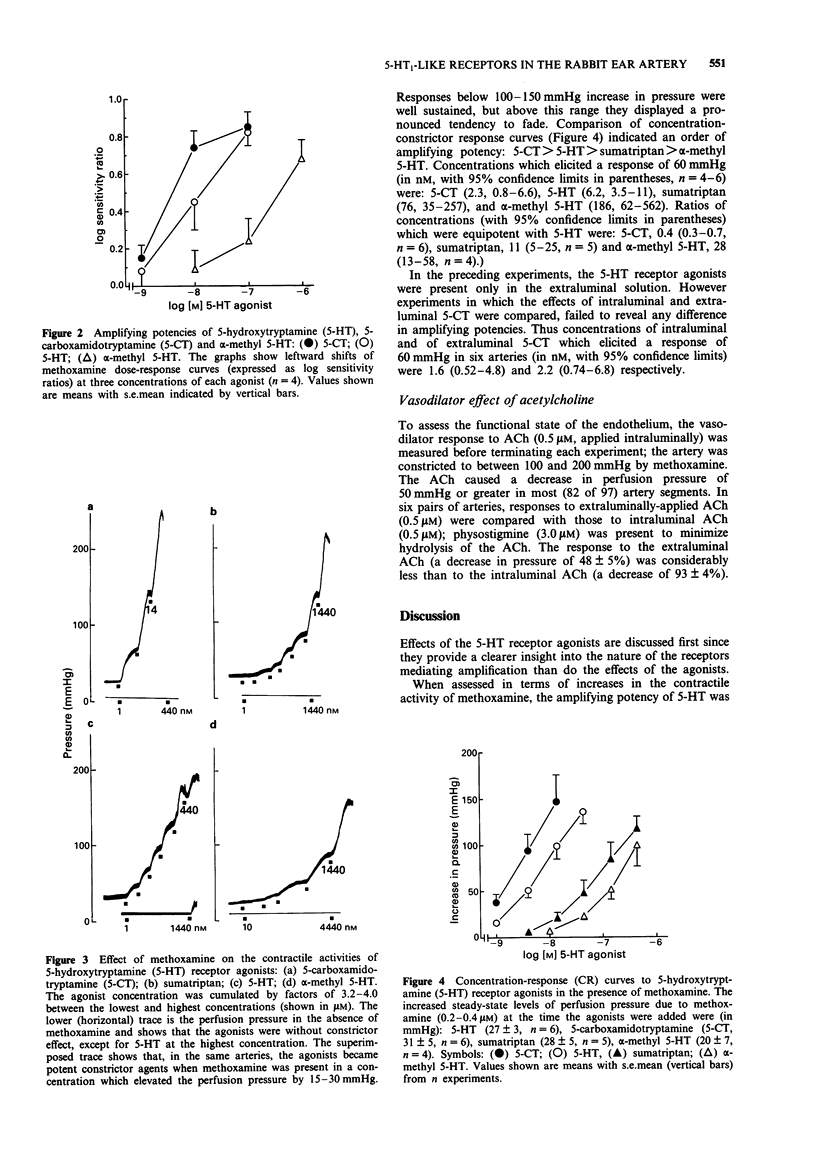
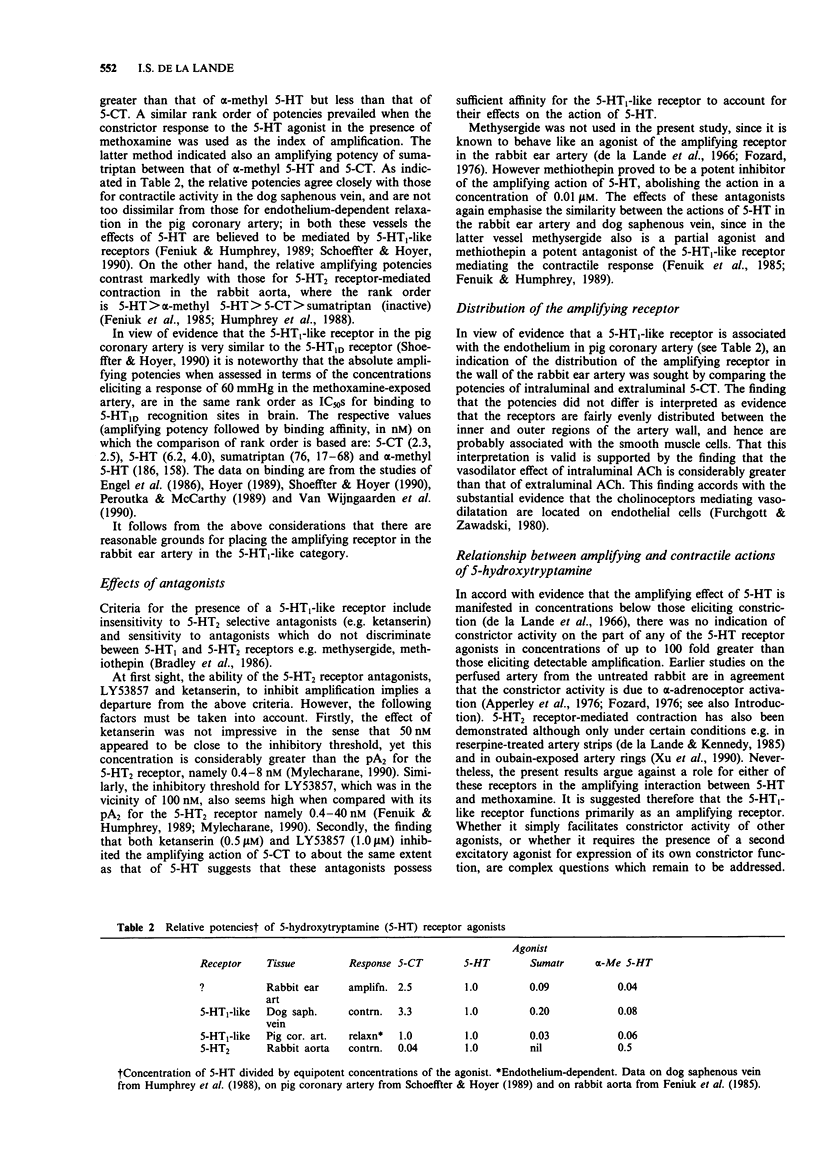
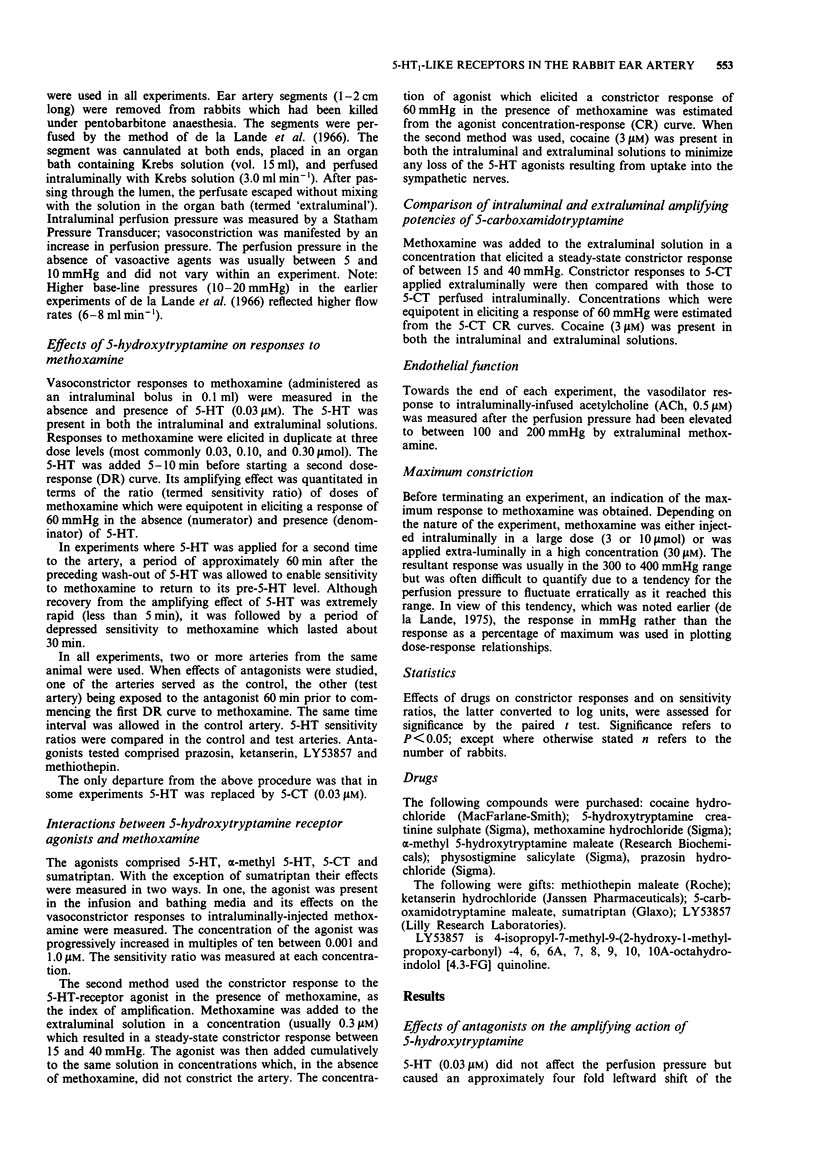
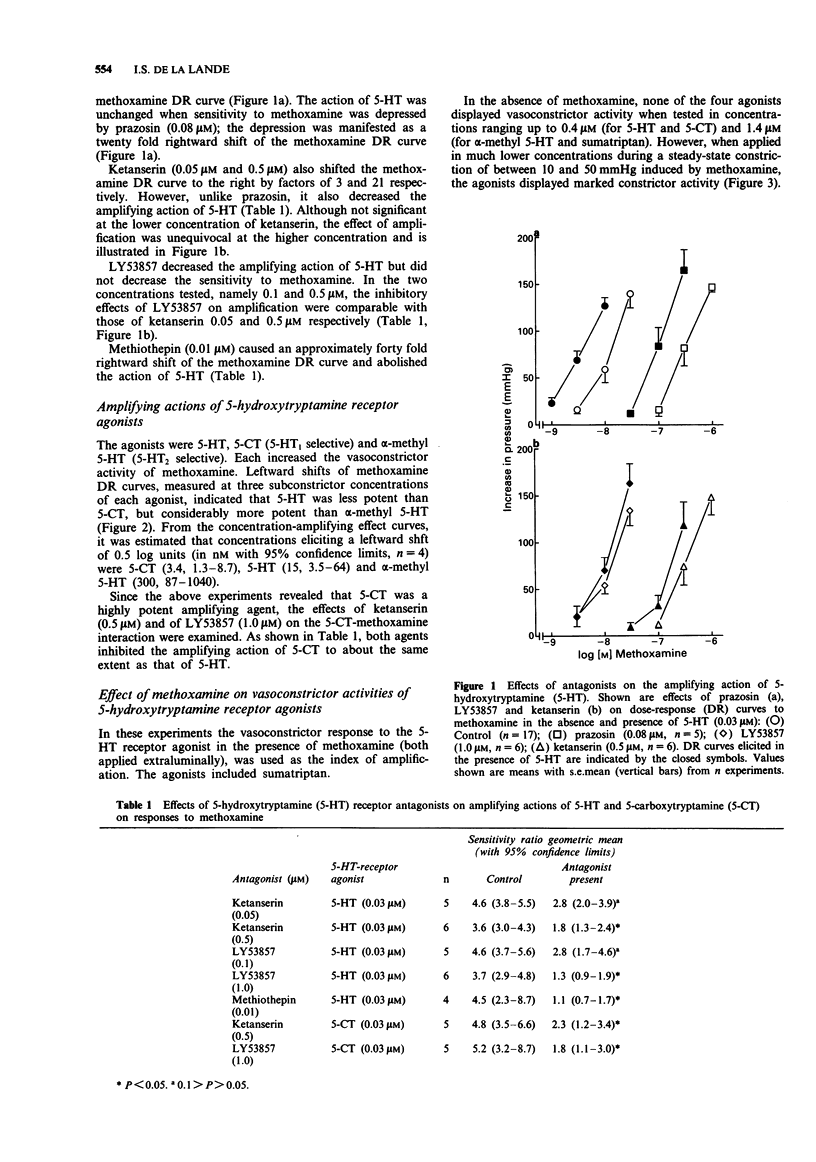
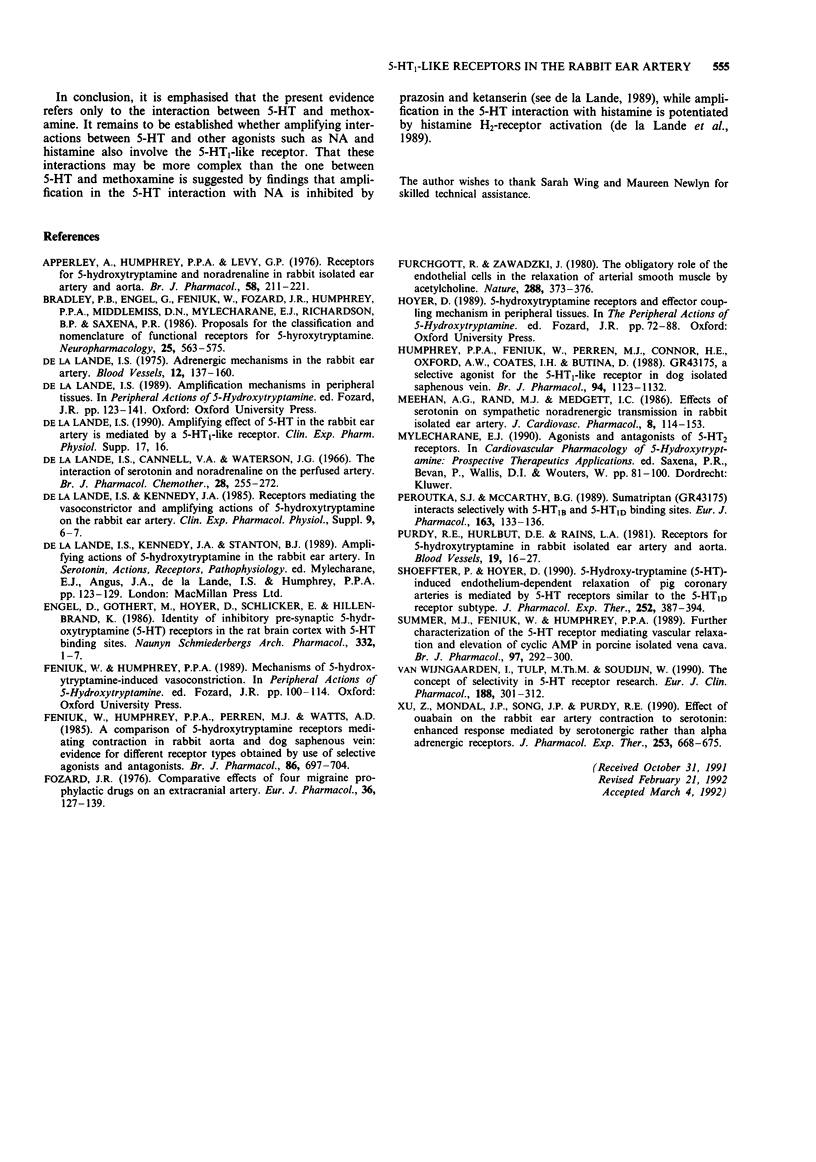
Selected References
These references are in PubMed. This may not be the complete list of references from this article.
- Apperley E., Humphrey P. P., Levy G. P. Receptors for 5-hydroxytryptamine and noradrenaline in rabbit isolated ear artery and aorta. Br J Pharmacol. 1976 Oct;58(2):211–221. doi: 10.1111/j.1476-5381.1976.tb10398.x. [DOI] [PMC free article] [PubMed] [Google Scholar]
- Bradley P. B., Engel G., Feniuk W., Fozard J. R., Humphrey P. P., Middlemiss D. N., Mylecharane E. J., Richardson B. P., Saxena P. R. Proposals for the classification and nomenclature of functional receptors for 5-hydroxytryptamine. Neuropharmacology. 1986 Jun;25(6):563–576. doi: 10.1016/0028-3908(86)90207-8. [DOI] [PubMed] [Google Scholar]
- Feniuk W., Humphrey P. P., Perren M. J., Watts A. D. A comparison of 5-hydroxytryptamine receptors mediating contraction in rabbit aorta and dog saphenous vein: evidence for different receptor types obtained by use of selective agonists and antagonists. Br J Pharmacol. 1985 Nov;86(3):697–704. doi: 10.1111/j.1476-5381.1985.tb08948.x. [DOI] [PMC free article] [PubMed] [Google Scholar]
- Fozard J. R. Comparative effects of four migraine prophylactic drugs on an isolated extracranial artery. Eur J Pharmacol. 1976 Mar;36(1):127–139. doi: 10.1016/0014-2999(76)90264-8. [DOI] [PubMed] [Google Scholar]
- Furchgott R. F., Zawadzki J. V. The obligatory role of endothelial cells in the relaxation of arterial smooth muscle by acetylcholine. Nature. 1980 Nov 27;288(5789):373–376. doi: 10.1038/288373a0. [DOI] [PubMed] [Google Scholar]
- Humphrey P. P., Feniuk W., Perren M. J., Connor H. E., Oxford A. W., Coates L. H., Butina D. GR43175, a selective agonist for the 5-HT1-like receptor in dog isolated saphenous vein. Br J Pharmacol. 1988 Aug;94(4):1123–1132. doi: 10.1111/j.1476-5381.1988.tb11630.x. [DOI] [PMC free article] [PubMed] [Google Scholar]
- Peroutka S. J., McCarthy B. G. Sumatriptan (GR 43175) interacts selectively with 5-HT1B and 5-HT1D binding sites. Eur J Pharmacol. 1989 Apr 12;163(1):133–136. doi: 10.1016/0014-2999(89)90406-8. [DOI] [PubMed] [Google Scholar]
- Purdy R. E., Hurlbut D. E., Rains L. A. Receptors for 5-hydroxytryptamine in rabbit isolated ear artery and aorta. Blood Vessels. 1981;18(1-2):16–27. doi: 10.1159/000158334. [DOI] [PubMed] [Google Scholar]
- Schoeffter P., Hoyer D. 5-Hydroxytryptamine (5-HT)-induced endothelium-dependent relaxation of pig coronary arteries is mediated by 5-HT receptors similar to the 5-HT1D receptor subtype. J Pharmacol Exp Ther. 1990 Jan;252(1):387–395. [PubMed] [Google Scholar]
- Sumner M. J., Feniuk W., Humphrey P. P. Further characterization of the 5-HT receptor mediating vascular relaxation and elevation of cyclic AMP in porcine isolated vena cava. Br J Pharmacol. 1989 May;97(1):292–300. doi: 10.1111/j.1476-5381.1989.tb11953.x. [DOI] [PMC free article] [PubMed] [Google Scholar]
- Xu Z., Mondal G., Song J. P., Purdy R. E. Effect of ouabain on the rabbit ear artery contraction to serotonin: enhanced response mediated by serotonergic rather than alpha adrenergic receptors. J Pharmacol Exp Ther. 1990 May;253(2):668–675. [PubMed] [Google Scholar]
- de la Lande I. S. Adrenergic mechanisms in the rabbit ear artery. A review. Blood Vessels. 1975;12(3):137–160. doi: 10.1159/000158046. [DOI] [PubMed] [Google Scholar]
- van Wijngaarden I., Tulp M. T., Soudijn W. The concept of selectivity in 5-HT receptor research. Eur J Pharmacol. 1990 Jun 12;188(6):301–312. doi: 10.1016/0922-4106(90)90190-9. [DOI] [PubMed] [Google Scholar]


